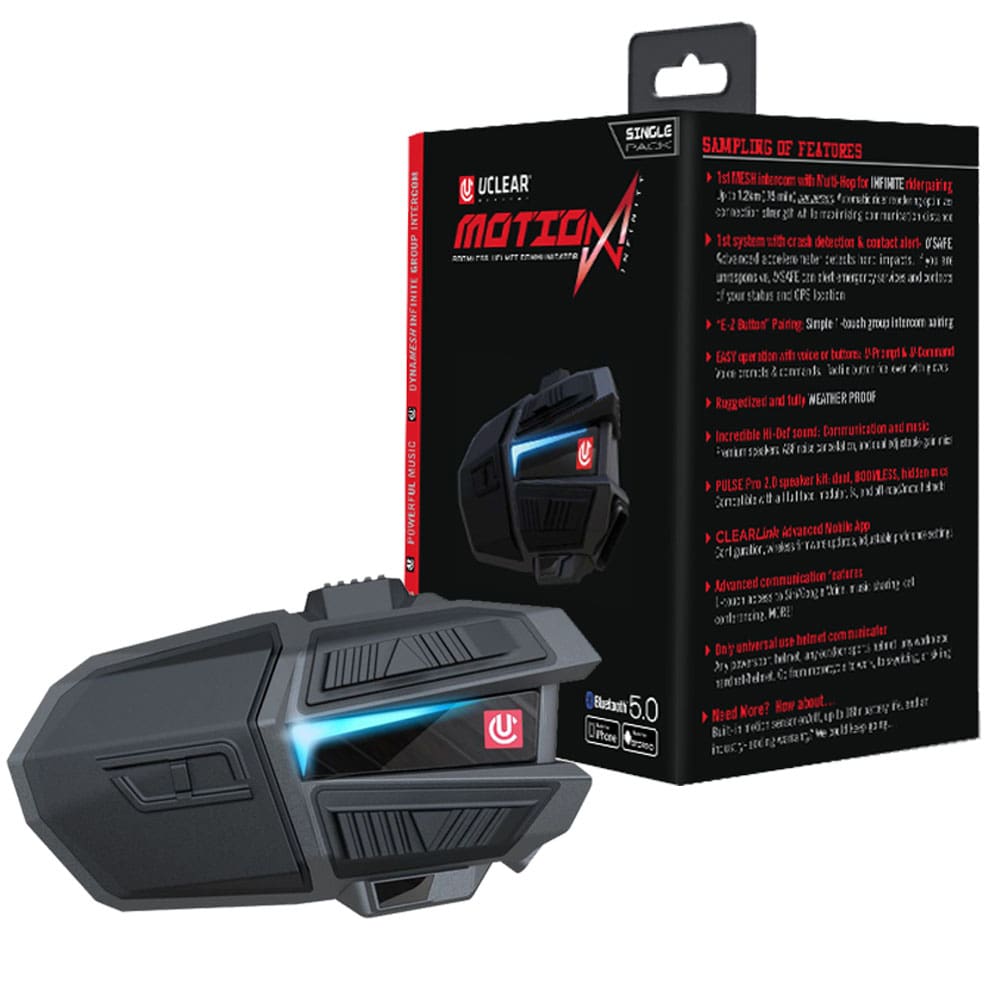Wouldn’t it be great if pairing your pesky bluetooth comms devices was a thing of the past? Turns out it is
The tone of the conversation changed for the better every time Eric dropped out. Frankly, we didn’t give a rat’s about the upcoming election, not here today on the bikes. Eric, faithful little pup that he can be, shook it like a bone as if his doggedness would win us all over to his side of politics. When he spoke, he wasn’t debating; he was berating.
And inside our helmets, we couldn’t get away from his determined lectures flooding over the Bluetooth communications. So when his Bluetooth somehow lost contact with the rest of us (or sometimes just a few of us), we celebrated by disparaging him as the airwaves went blessedly quiet until he finally reconnected.
All it took was someone to say something innocent like, “Check out the mob of emus on the left,” and Eric was off again with steadfast beliefs about leftists and rightists. Like democracy, Bluetooth is a pretty good thing but with flaws, and Eric was unwittingly exposing some of them: democracy’s flaws when we could hear him, Bluetooth’s when we couldn’t.
Bluetooth communications technology is great stuff when it works well. But of course it doesn’t always work well, despite more than 20 years of development. As ubiquitous as Bluetooth has become, it’s still just another form of wireless communication, prone to the vagaries of distance, interference, and the complex digital signals that control it.
Bluetooth may seem to be magical, but it isn’t. In fact, it turns out it is pretty simple stuff in some ways — just a short daisy-chain of devices that rely on their order and proximity to communicate properly. It is rather set in its ways of networking, with rigid structures that don’t always suit the fluid formations of a group of motorcycle-riding mates on the road.
That’s being changed by mesh technology, a relatively new development that is now beginning to appear in motorcycle intercom systems. Think of it as a net that can be cast over all the riders, connecting them as a group, instead of in a chain. Communications going in every direction rather than down the line.
There is no hierarchy of signals, but true equality without a central point or leadership role. Strewth, I hope Eric doesn’t read this…
One of the most valuable features of mesh technology is the ability of every device in the network to act as a relay, retransmitting information to every device around it. Every device in the network can do it, which means a web of connections rather than a chain. An indirect link through a third device is as good as a direct link between two devices.
In the older systems, devices were effectively connected in a chain. No, it didn’t really seem that way when you used them. A number of individuals on different bikes, and including pillions, could all have a chat. But it did rely on the devices being connected in line, like a row of kids holding hands and passing messages down the line.
In the most limited setups, it could mean that if one rider dropped back in the order and ended up out of range, those ‘behind’ that rider in the chain of connections (as opposed to the order the bikes are travelling in) would drop out of touch, too. If someone in the middle of the group left permanently, everyone else would have to stop and re-pair their devices.
In mesh, it no longer matters where anyone is in the order. Nor does it matter if they get a long way from any of those devices, because any (or all) of the others in between will be capable of relaying information. With this technological chatter going in every possible direction, it’s virtually impossible for someone to lose contact as long as they’re within cooee of someone else in the group.
If a rider is disconnected from the group, the new technology will automatically search for them and, when it finds them, reconnect them. Simple Bluetooth systems would do this too, but not as cleverly nor successfully. The automatic reconnection technology has moved ahead, but primarily it comes down to the fact that every device can listen out for the lost one, and when one finds it, all find it.
The range of the whole network is dramatically improved by the relaying technology. Manufacturers claim anything between 800m and 2km, depending upon the signal strength they’ve built into their units — and that’s just from one device to the next. Connect a group of riders and the communication can range over a few kilometres. The best we’ve seen so far is about 8km potential range!
As you’d expect, built-in security protocols in mesh communications prevent uninvited listeners from joining in. However, most manufacturers provide a public communication option, one where anyone else with an unsecured connection can, when within range, say g’day.
This sort of open system could be useful at times. On a club ride, it might be a good way to let a faster non-club rider come safely through the group. It might work well for some riders during public mass rides. As more riders adopt mesh comms, it will work itself out.
There is theoretically no limit to the number of riders who can join a network, although the reality is not quite that good. On a public system, you can certainly have more people on the network than could possibly talk at once in any clear way. But on private connections, manufacturers keep the numbers down.
Still, those limited numbers might be a dozen or 16 or 20, varying by brand and system. That’s probably plenty, and if it’s not, well, maybe use a public one anyway.
Beyond the crowd of talkers, the flexibility of mesh connectivity permits additional tasks to be included without your having to switch between them. Assuming the manufacturer has enabled it, there’s no reason why you can’t be chatting to your mates while streaming music from your phone, listening to radio, taking phone calls and/or following direction from your GPS. No one else in the group will hear your music or GPS instructions.
Control of all these complex options for communication and connection is put in your hands by an app. The transmitter on your helmet is, in most cases, a simple one-button affair. Hit the button to turn it on, and it takes over all duties automatically — searching for other devices, making connections, re-establishing lost connections, relaying information on behalf of others and so on. Hit the button again and it’ll turn off.
But the app will provide the means to specify who’s in your group, to broadcast publicly with anyone who’ll listen, to blend music, phone and navigation into your ride.
The apps are individual to manufacturers, of course, designed for their mesh systems. In fact, each brand’s mesh programming and hardware will be subtly different. They can all still communicate with each other, but just like motorcycles, some are built differently from others.
Therefore it pays to shop around. Find out what specifications and features you are getting for your money. DynaMESH, Mesh Intercom, Dynamic Mesh Communication (from UCLEAR, Sena and Cardo respectively) and other proprietary products are all mesh systems built for use on Bluetooth platforms, but the software and hardware was created by different people.
This isn’t the place for a comparison between them, but we do want to make the point that each will have different strengths and weaknesses from the others. Pay attention not only to the price, but things such as range, potential group size, quality and so on.
In some cases, you can even get voice operation (another virtual servant to line up alongside Siri and Alexa). Some offer control through hand gestures. These features aren’t necessarily a result of mesh technology but it’s all pretty exciting.
We just have to wonder whether it’ll ever be possible to have the mesh system recognise a command like, “Mute Eric.” Or maybe it’ll let us wave him away. Freedom of speech is one thing, but all this new-found freedom of communications enabled by mesh does have its downside.
Then again, Eric’s political speeches are a small price to pay for what mesh communications technology has brought us. There’s a lot we’re gaining from it, not least
of which is the simple pleasure of very reliable connection over longer ranges in big or
small groups.
WHAT’S OLD IS NEW, SORT OF
Bluetooth mesh technology is backwards-compatible, meaning older Bluetooth devices can connect to a Bluetooth mesh device. It is not quite that simple, though, when we’re talking about rider-to-rider communications systems.Some mesh systems won’t tolerate an older Bluetooth device without losing most or all of their mesh advantages. Others claim to have no such limitations at all when mixing with non-mesh devices. UCLEAR DynaMESH is one of these.
There is a neat way that you can join a mesh network without upgrading your existing in-helmet Bluetooth headset, though: use a mesh adapter. One example is Sena’s +Mesh adapter. When paired with your older Bluetooth headset, an adapter gives you many of the advantages of being part of a mesh network with your riding mates. But the system has limitations. Your non-mesh headset pairs with the adapter, and it’s the adapter that communicates with the broader network. If you also pair your headset with, say, your pillion’s non-mesh Bluetooth headset, they’ll hear all the voice prompts coming through the adapter. You likely won’t have multitasking ability, either. With your phone connected to your headset by Bluetooth, an incoming phone call may override your connection to the adapter, forcing you to have to pair again afterwards.

MESH IS NOT BLUETOOTH
Mesh technology can be applied to all sorts of wireless protocols, one of which is Bluetooth. In almost all motorcycle communications systems, Bluetooth is simply the product of choice; mesh is then another layer of technology added to it.
Other wireless systems include ZigBee, Thread and Z-Wave. Some of these are considered better than Bluetooth in certain applications, but we won’t go into that comparison here. It’d lead us into industrial lighting systems, smart houses and a dozen other fields that aren’t nearly as much fun as riding motorcycles.
But think of it: set up your smart house so that your mesh headset can communicate with it, and as you get home you can tell the garage doors to open, the lights to come on, the music in your helmet to start streaming in the house, and your robo-servant to be waiting for you at the door with a cold beer.
